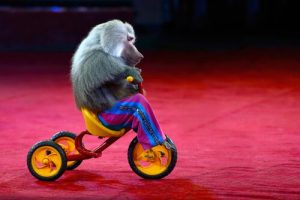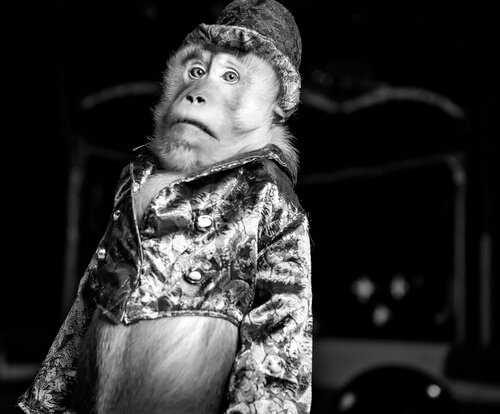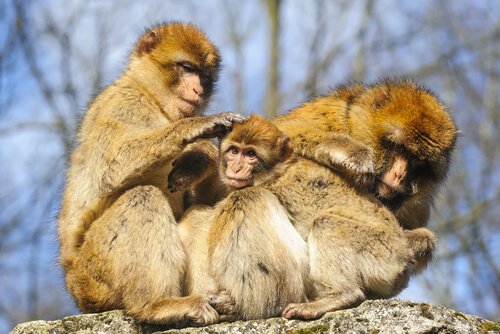Animal Cruelty: an ape dressed in clothing isn't funny


Written and verified by the vet Eugenio Fernández Suárez
It’s unbelievable to think that in 2018 it’s still necessary to state that dressing apes in clothing isn’t funny at all and that sharing images of primates dressed in clothes is a clear example of animal cruelty.
Apes dressed in clothing and other cases of primate cruelty
On the internet and in movies, you often see images of apes with clothes on or having human-like behaviors that aren’t natural for them. Although it may seem funny, there is actually a dark reality behind it.
Whenever you see a humanized animals, which are animals that behave in unnatural ways, like riding a bike or smoking. This also includes humanizing behaviors that have human explanations for wild acts.
As mentioned, apes suffer a lot as pets because they depend a lot on their mothers. Unfortunately, young apes are stolen from their mothers to become pets. This is the case for the protagonists of the following images.
When people have monkeys as pets or as performers on TV, nobody wants to see them behave like a wild animal because this makes them dangerous. So, when we see apes that are dressed up, we know that it’s humanized and that it has been trained.

Apes fake smiles
There are other indications of this animals suffering. Many primates communicate through their facial gestures, but their meanings are different than to humans’.
While smiling for humans is a good thing, apes show their teeth as a way of expressing fear. When these animals feel terrified, they show their teeth as their main weapon.
When people see an ape dressed up or acting like a human, it’s often an expression of fear. This may look funny to people, but these animals are actually trained through fear and abuse.
There’s only one way to make an animal look scary when you want it to. In fact, it’s been shown that the majority of primates that are in movies show this kind of behavior.
Consequences of humanizing primates
Separating these animals from their mothers in order to humanize them has multiple consequences because the relationship between mothers and offspring is strong among all primates, from the human species to the Capuchin monkey.

That is why using these animals as pets or for movies causes psychological problems similar to those that orphans experience when they are abused and have never been shown affection. They are complex and wild animals that must live in large groups of the same species.
However, there are other, lesser known, consequences. For example, it has been proven that reposting images of apes dressed in clothing or as pets increases the rate of illegal trafficking of this species, which puts these animals in danger of extinction.
The Slow Loris
One of the most well-known cases is that of the slow loris, a poisonous mammal that was increasingly getting snatched from its natural habitat due to youtube videos that showed it as a pet.
This is a great example because the video shows a case of the humanization of wild behaviors. The loris appears to raise its arms when people tickle it. However, this is a defense mechanism because there are poisonous glands on their elbows.
Numerous authorities have denounced the humanization of animals to have them as pets or use them in the entertainment industry. One of the most well known is Jane Goodall, who has rescued numerous chimpanzees and other species that are in her primate sanctuaries. She has personally asked everyone to stop sharing these kinds of images on social media.
It’s unbelievable to think that in 2018 it’s still necessary to state that dressing apes in clothing isn’t funny at all and that sharing images of primates dressed in clothes is a clear example of animal cruelty.
Apes dressed in clothing and other cases of primate cruelty
On the internet and in movies, you often see images of apes with clothes on or having human-like behaviors that aren’t natural for them. Although it may seem funny, there is actually a dark reality behind it.
Whenever you see a humanized animals, which are animals that behave in unnatural ways, like riding a bike or smoking. This also includes humanizing behaviors that have human explanations for wild acts.
As mentioned, apes suffer a lot as pets because they depend a lot on their mothers. Unfortunately, young apes are stolen from their mothers to become pets. This is the case for the protagonists of the following images.
When people have monkeys as pets or as performers on TV, nobody wants to see them behave like a wild animal because this makes them dangerous. So, when we see apes that are dressed up, we know that it’s humanized and that it has been trained.

Apes fake smiles
There are other indications of this animals suffering. Many primates communicate through their facial gestures, but their meanings are different than to humans’.
While smiling for humans is a good thing, apes show their teeth as a way of expressing fear. When these animals feel terrified, they show their teeth as their main weapon.
When people see an ape dressed up or acting like a human, it’s often an expression of fear. This may look funny to people, but these animals are actually trained through fear and abuse.
There’s only one way to make an animal look scary when you want it to. In fact, it’s been shown that the majority of primates that are in movies show this kind of behavior.
Consequences of humanizing primates
Separating these animals from their mothers in order to humanize them has multiple consequences because the relationship between mothers and offspring is strong among all primates, from the human species to the Capuchin monkey.

That is why using these animals as pets or for movies causes psychological problems similar to those that orphans experience when they are abused and have never been shown affection. They are complex and wild animals that must live in large groups of the same species.
However, there are other, lesser known, consequences. For example, it has been proven that reposting images of apes dressed in clothing or as pets increases the rate of illegal trafficking of this species, which puts these animals in danger of extinction.
The Slow Loris
One of the most well-known cases is that of the slow loris, a poisonous mammal that was increasingly getting snatched from its natural habitat due to youtube videos that showed it as a pet.
This is a great example because the video shows a case of the humanization of wild behaviors. The loris appears to raise its arms when people tickle it. However, this is a defense mechanism because there are poisonous glands on their elbows.
Numerous authorities have denounced the humanization of animals to have them as pets or use them in the entertainment industry. One of the most well known is Jane Goodall, who has rescued numerous chimpanzees and other species that are in her primate sanctuaries. She has personally asked everyone to stop sharing these kinds of images on social media.
This text is provided for informational purposes only and does not replace consultation with a professional. If in doubt, consult your specialist.








